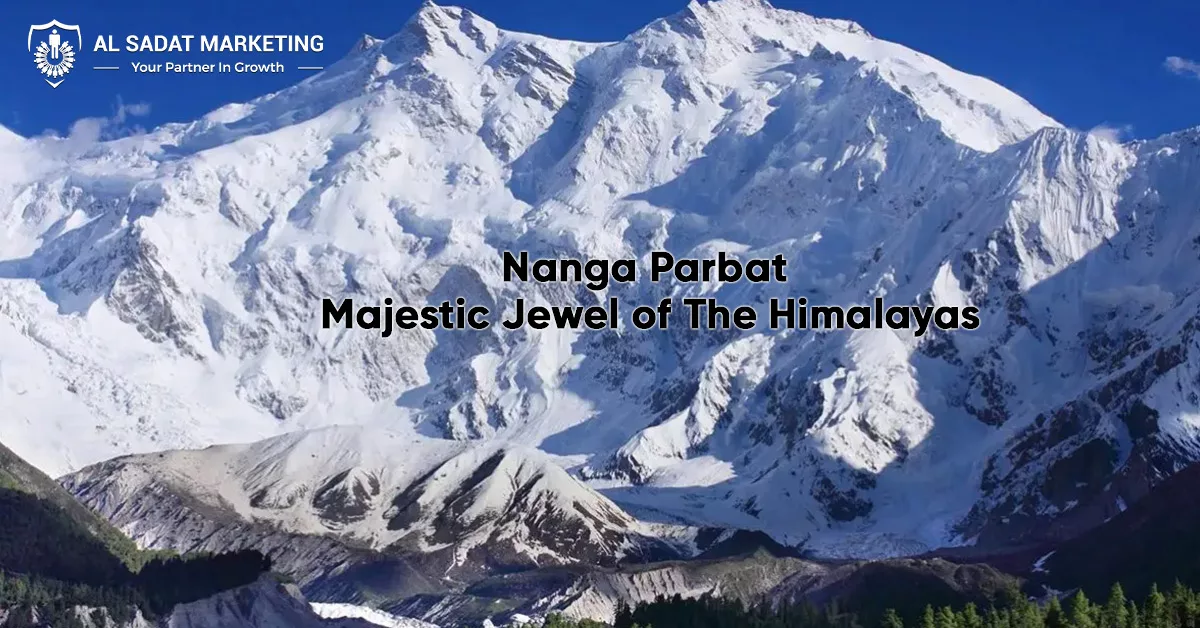Mountaineers and adventurers have long been drawn to the magnificent mountain known as Nanga Parbat, the ninth-highest peak in the world. Nanga Parbat beckons anyone seeking an unforgettable adventure because of its breathtaking landscape, extensive history, and challenging hurdles.
In this blog post, the Al Sadat Marketing Blogs will provide a comprehensive overview of Nanga Parbat, covering its historical adventures, cultural significance, geographic importance, and adventure prospects.
A Brief Introduction of Nanga Parbat

Rising to an astounding 8,126 meters (26,660 feet) in the Gilgit-Baltistan region of Pakistan’s Astore Valley, Nanga Parbat is the ninth-highest peak in the world. The name, meaning “Naked Mountain” in Urdu, refers to the wild and rugged landscape of its inclines. The mountain’s rugged terrain and remarkable prominence have molded its image as one of the toughest peaks for climbers.
Significant Elements
Nanga Parbat’s exceptional vertical relief over the surrounding region in all directions makes it one of the most identifiable mountains in the world. The southern Rupal Face of the mountain is the highest mountain face in the world, rising 4,600 metres (15,090 ft) above its base.
Read More: The Pride of Himalaya: Nanga Parbat
Conversely, the northern Rakhiot Flank provides a less steep but more complicated climb; from the Indus River valley, it takes approximately 25 kilometers (16 miles) to reach the summit. It is in the top ten on the planet for the shortest distance traveled thanks to its incredible height increase of 7,000 meters (23,000 feet).
Of the world’s twenty highest mountains and most famous peaks, Nanga Parbat and Mount Everest are the only two peaks that are ranked ninth and fourteenth, respectively. The other summit that holds this distinction is the well-known Mount Everest, which comes in #1 on both lists.
Read More: Promoting Inbound Tourism | Pakistan Participates In SCO Tourism Forum 2023
In addition, the mountain is the second-most recognizable Himalayan peak, behind Mount Everest. Because of its strategic location, it is connected to higher peaks in the Himalaya-Karakoram range. The significant col is situated in the Kashmir Valley at Zoji La.
The easternmost peak of the Himalayas is Nanga Parbat, which is situated on the Tibetan Plateau; the easternmost tip of this amazing mountain range is Namcha Barwa.
Geographical and Cultural Influence

With a wide variety of geological formations and stunning natural splendor, Nanga Parbat is tucked away between the towering Himalayan and Karakoram ranges. The region’s well-known deep valleys, untainted glaciers, and rough terrain are what have produced the distinctive flora and wildlife that can be found nearby.
This massive mountain has significant cultural value as well. The locals hold the mountain in high regard and consider it to be a sacred location. The neighboring villages are home to several ethnic groups, such as the Balti, Dardic, and Shina people, all of which have managed to maintain their unique customs.
Tragic Incidences and Historical Journeys
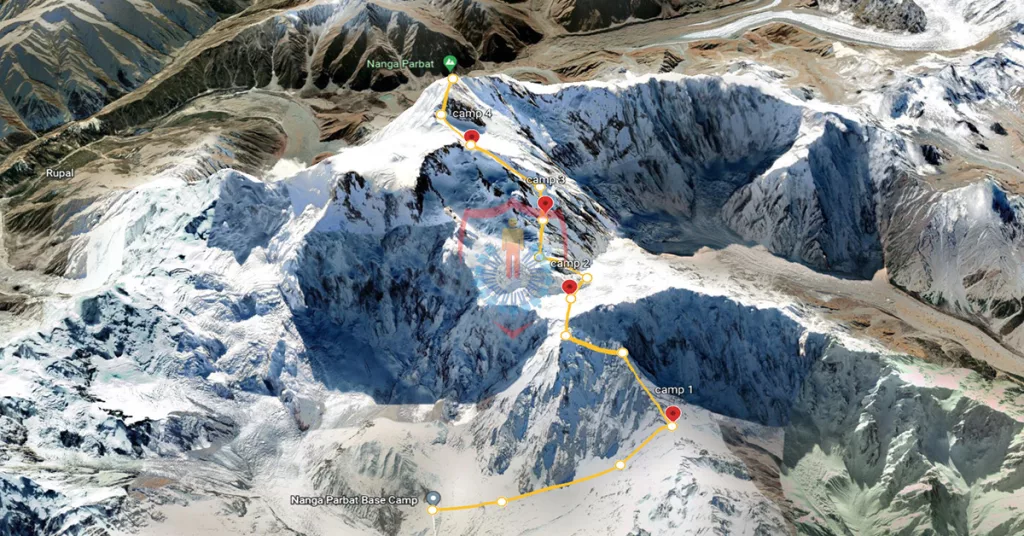
Mountaineering expeditions to Nanga Parbat have a lengthy history, filled with both successes and tragedies. In 1895, Albert F. Mummery and his group made the first known effort to ascend the mountain. But it wasn’t until 1953 that Austrian mountaineer Hermann Buhl was able to reach the summit.
Nevertheless, the peak’s creepy reputation came from the numerous mountaineering tragedies that have occurred there. One of the most horrific incidents of the 1937 German-American expedition led by Willy Merkl occurred when a powerful storm killed nine climbers. The attraction of the mountain and the enigmatic atmosphere it exudes has increased as a result of these instances.
Read More: An Overview of Indus Valley Civilisation
Exploration and Hiking

For those seeking a less challenging activity, Nanga Parbat offers fascinating hiking opportunities. The Rupal Valley Trek and the Fairy Meadows Trek are well-liked options that offer stunning views of the mountain and the surrounding area. Hiking these routes allows visitors to fully appreciate the stunning natural beauty of the region and the warm welcome of the locals.
The Nanga Parbat region is seeing a rise in adventure tourism, luring thrill-seekers from around the globe with activities like rock climbing, paragliding, and camping. The Karakoram Highway, sometimes referred to as the “Eighth Wonder of the World,” provides a breathtaking and exhilarating road trip to the foot of the mountain.
Routes for Climbing
In Nanga Parbat, there are numerous climbing routes, each with special difficulties and benefits. The two most popular choices among them are the Diamir Face and the Rakhiot Face. The “Normal Route,” sometimes called the Diamir Face, is the recommended route because of its relatively safe ascent and minimal technical difficulty. However, the Rakhiot Face presents more difficulties because of its sharp inclines, rockfalls, and perilous icefalls.
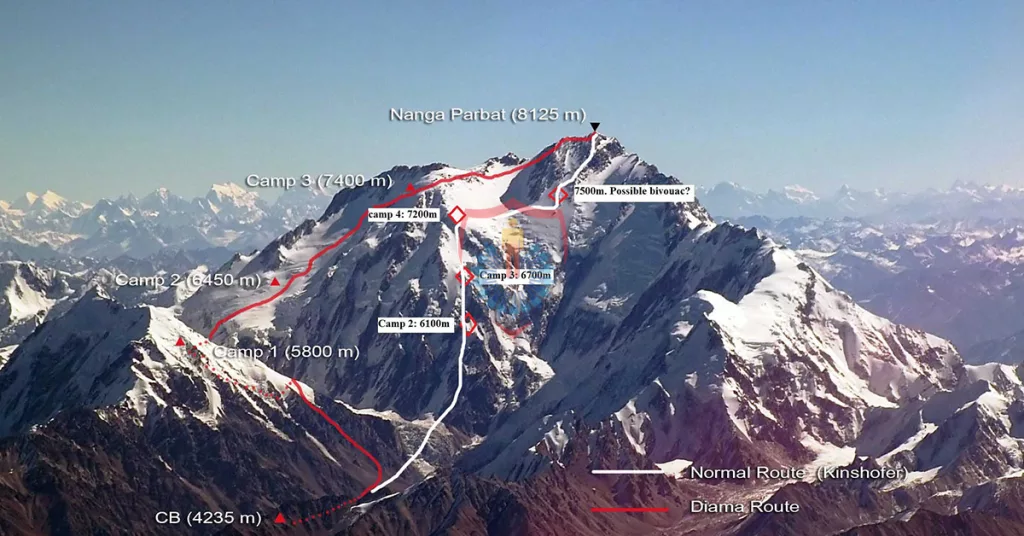
Moreover, achieving this summit calls for extraordinary physical endurance, flexibility at high altitudes, and a great deal of mountaineering expertise. Climbers should prepare for weather conditions that will make the ascent more challenging, such as extreme cold, strong winds, and many snowstorms.
Close-by Summits
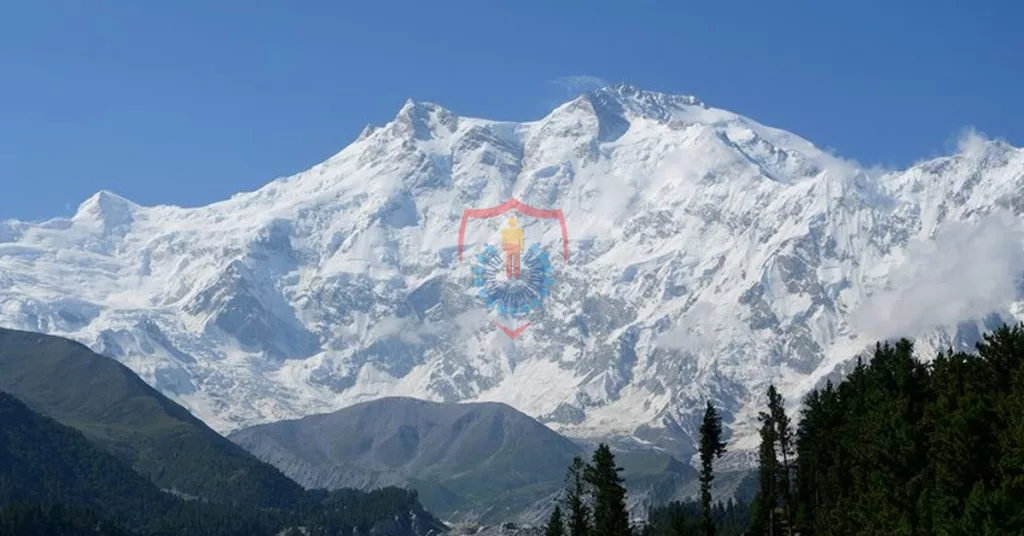
The following peaks are Nanga Parbat’s neighbors:
- Peak Rakhiot
- Chongra Peak
- Mazeno Peak
- Rupal Peak
- Laila Peak in the Ruby Valley
- Shaigiri
Peak Rakhiot
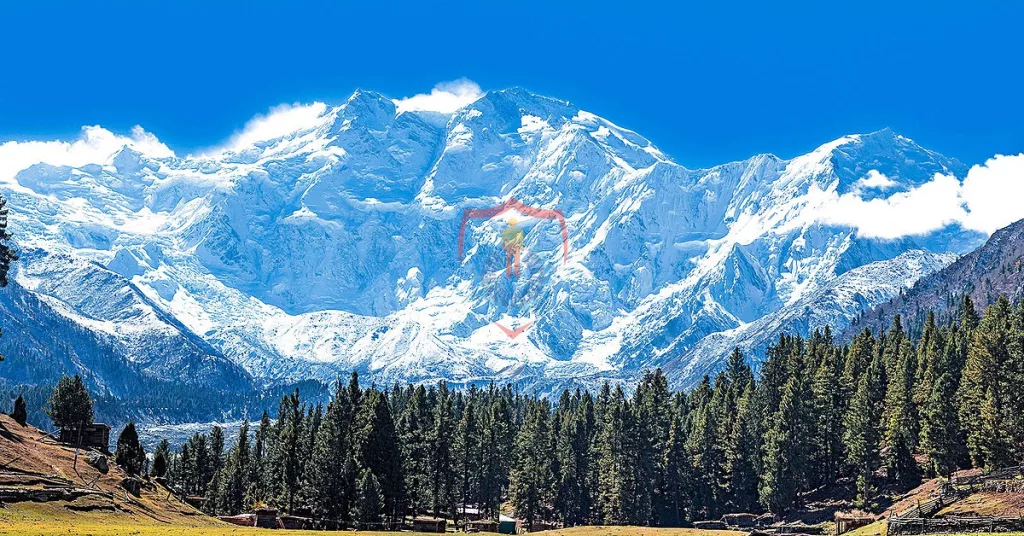
Part of the Himalayas, Rakhiot Peak is a 7,070-meter mountain in Gilgit-Baltistan, Pakistan. It is one of the six peaks that surround Nanga Parbat, the ninth-highest mountain in the world. The technically challenging mountain of Rakhiot Peak has only seen a few number of ascents. In 1977, a Japanese team accomplished the first successful ascent of Rakhiot Peak.
The Chongra Peak
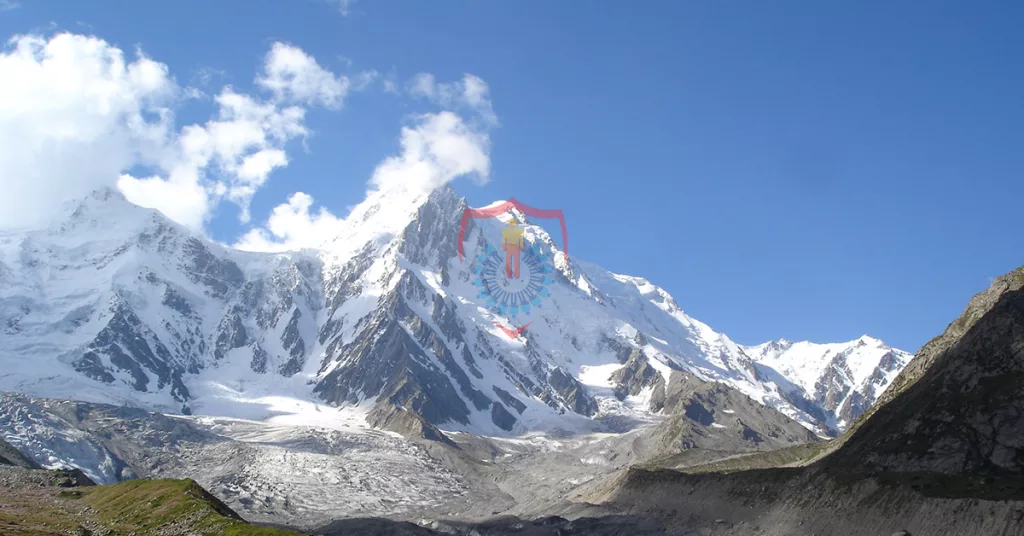
The 6,893-meter Chongra Peak is a peak located in the Himalayas. It’s one of the six peaks that surround the summit. Because Chongra Peak is easier to access technically than Rakhiot Peak, climbers prefer it. In 1966, a German team accomplished the first successful ascent of Chongra Peak.
Mazeno Peak

Mazeno Summit, at 6,610 meters, is the third-highest summit in the vicinity of Nanga Parbat. This is a favorite peak among climbers, who often climb it first to gain altitude adjustment before attempting the summit. In 1957, an Austrian expedition successfully ascended Mazeno Peak for the first time.
Rupal Peak
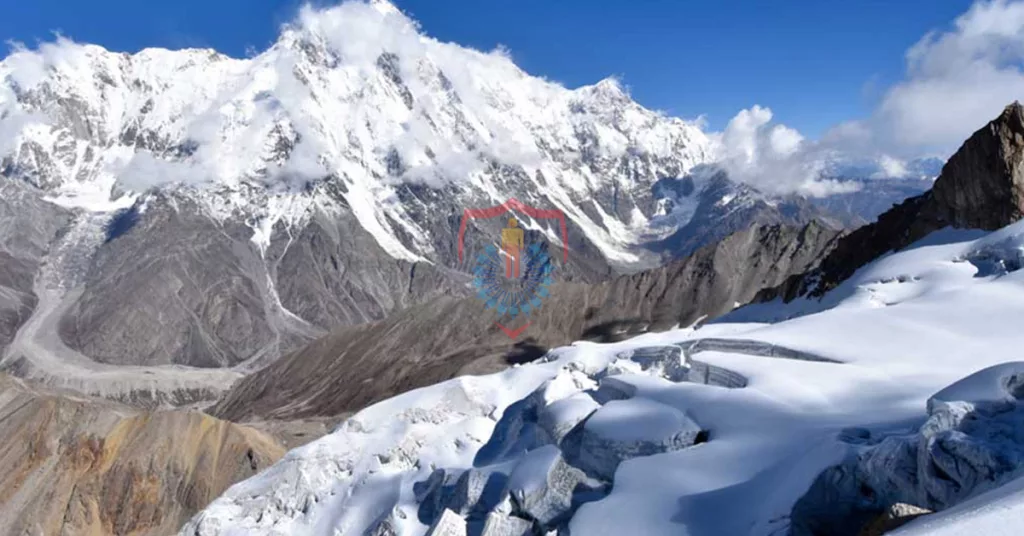
Rupal Peak, a 5,642-meter mountain, is located just south of the peak. Because it’s a fairly easy mountain to climb, climbers often use it as a warm-up for harder adjacent summits. Rupal Peak was ascended successfully for the first time in 1964.
Laila Peak (Ruby Valley)

Part of the Himalayas is the 5,971-meter Laila Peak in Gilgit-Baltistan, Pakistan. It’s situated southwest of it. Laila Peak is more difficult to climb than Rupal Peak, although it is less technically challenging than Rakhiot Peak or Chongra Peak. The first ascent of Laila Peak was accomplished in 1970.
Shigri

Situated in Pakistan’s Gilgit-Baltistan region of the Himalayas, Shaigiri is a 5,690-meter mountain. Located immediately west of Nanga Parbat. Shaigiri is a favorite peak for trekkers and mountaineers, and many of them ascend it en route to Nanga Parbat Base Camp. The first successful summit attempt on Shaigiri occurred in 1978.
Gorgeous vistas From all these summits, views extend to Nanga Parbat and the surrounding Himalayas. All of them are challenging to climb, but they’re all worthwhile experiences for hikers and climbers alike.
Conclusion
Nanga Parbat, well-known for its breathtaking scenery, intriguing past, and difficult terrain, never fails to entice climbers and adventurers seeking the experience of a lifetime. This magnificent summit perfectly combines amazing landscapes, a wide variety of civilizations, and exhilarating experiences. Your soul will surely be changed by a trip to this mountain, regardless of whether your objective is to summit it or simply take in the amazing vistas.
As you prepare for your adventure or walk, it is your duty to show respect for the mountain, observe safety precautions, and interact with the locals in a dignified manner. Nanga Parbat beckons those who dare to explore its splendor with its breathtaking beauty.
Frequently Asked Questions (FAQs)
Here is a compilation of the most common questions about Nanga Parbat along with their answers.
Q1: Where is Nanga Parbat located?
The province of Gilgit-Baltistan in Pakistan is home to Nanga Parbat.
Q2: What is the elevation of Nanga Parbat?
The nineteenth highest summit in the world, Nanga Parbat is located 8,126 meters (26,660 feet) above sea level.
Q3: How does one interpret the word “Nanga Parbat”?
“Naked Mountain,” as the Urdu word “Nanga Parbat” refers to the bleak and sheer character of its slopes.
Q4: Which climbing routes on Nanga Parbat are the most popular?
Nanga Parbat has two of the most popular climbing routes: the Diamir Face and the Rakhiot Face.
Q5: What is the cultural importance of Nanga Parbat?
This mountain is sacred to the local indigenous population and holds cultural importance for the neighboring communities.
Q6: What hiking opportunities are there near Nanga Parbat?
The Rupal Valley trek, commonly referred to as the Fairy Meadows Trek, is a well-liked excursion in the Nanga Parbat area.
Q7: Can you tell me the history of Nanga Parbat’s rock climbing adventures?
Nanga Parbat has a rich history of climbing triumphs and tragedies, with some of the most notable expeditions dating back to the late 1800s.
Q8: What kinds of challenges does Nanga Parbat present for climbers?
One of the challenges faced by mountain climbers is the risk of high altitude, challenging terrain, and severe weather.
Q9: What exciting activities are accessible near Nanga Parbat?
Near the mountain, one can engage in adventure sports including rock climbing, camping, and paragliding.
Q10: When traveling to Nanga Parbat, what safety precautions should be taken?
Use caution when ascending the mountain by treating it with respect, following safety guidelines, and being mindful of the surrounding communities.
You can also invest in other famous and most in demand housing societies, such as , Blue World City, Rudn Enclave, 7 Wonders City Peshawar, Taj Residencia, Kingdom Valley, New Metro City Gujar Khan, Forest Town Rawalpindi, University Town Rawalpindi, ICHS Town, Park View City Islamabad, Multi Gardens B17 Islamabad and Nova City Islamabad.
Al Sadat Marketing please contact 0331 1110005 or visit https://alsadatmarketing.com/
Few more real estate housing schemes which are trending now a days in Islamabad by including: Faisal Town Phase 2, Prism Town Gujar Khan, New City Paradise, Eighteen Islamabad, 7 Wonders City Islamabad, Capital Smart City, Silver City Islamabad, The Life Residencia, Faisal Town Islamabad, Islamabad Golf City, Islamabad Model Town and Marble Arch Enclave.
Al Sadat Marketing is an emerging Real Estate Agency headquartered in Islamabad, Pakistan. With over 10+ Years of experience, Al Sadat Marketing is providing its services and dealing all trending housing societies projects in different cities of Pakistan. Islamabad Projects, Rawalpindi Projects, Gujar Khan Projects, Burhan Projects, and Peshawar Projects etc.
Book Your Plot Now: +92 331 111 0005


